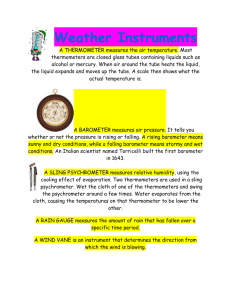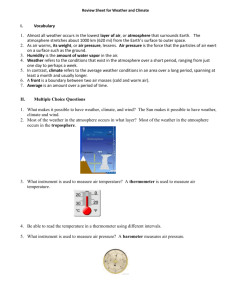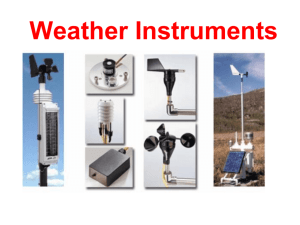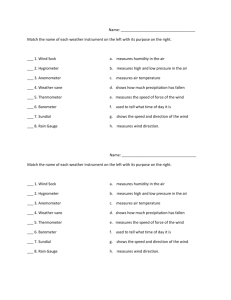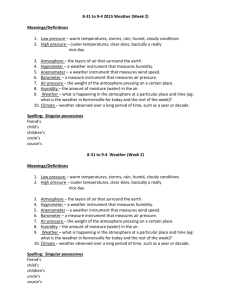Relative Humidity
advertisement
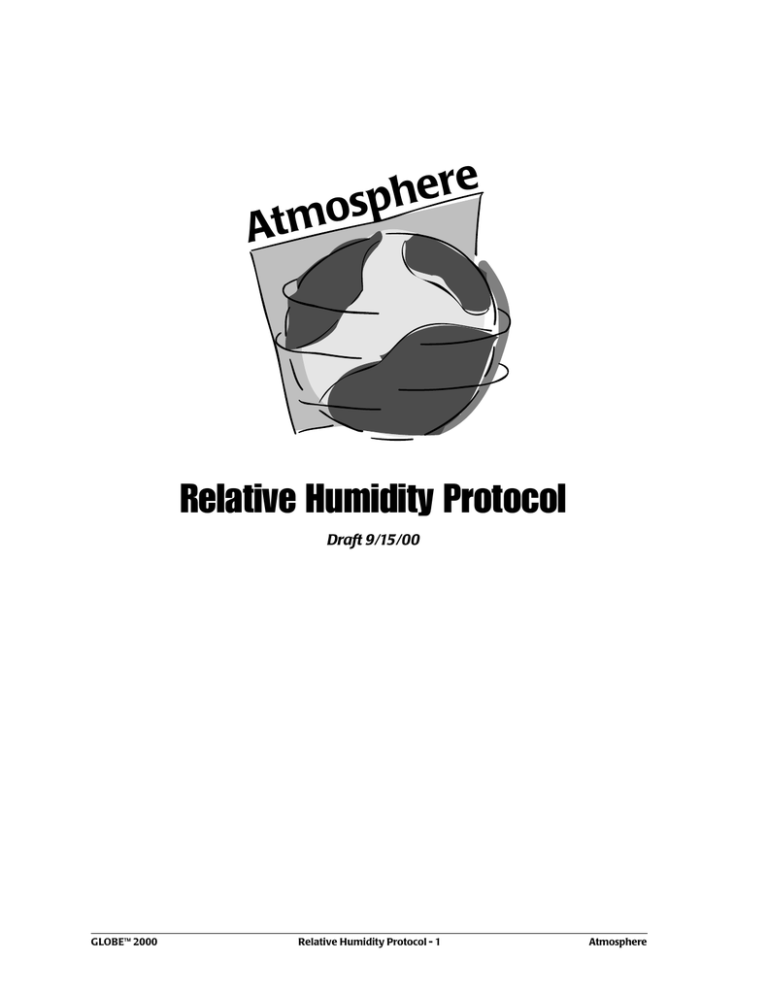
Atm e r e h osp Relative Humidity Protocol Draft 9/15/00 GLOBE™ 2000 Relative Humidity Protocol - 1 Atmosphere Relative Humidity Protocol Purpose Frequency To measure relative humidity at an Atmosphere Study Site Daily, preferably within one hour of local solar noon Student Outcomes Key Concepts Students learn to quantify humidity and that there is a limit to the amount of water vapor which the air can hold. Students gain insight into why rain drops and snow flakes form and why there is precipitation. Latent heat Evaporation Condensation Water vapor Dew point Radiation Skills Overview Sling Psychrometer: Students check that the sling psychrometer has water in it to wet the bulb of one of the thermometers and read the temperature of the dry bulb thermometer. Then they sling the thermometers around for 3 minutes and read the wet bulb temperature. Relative humidity is determined from the wet and dry bulb temperature readings using a table or slide calculator. Digital Hygrometer: Students place the digital hygrometer in the instrument shelter and return to read the value after at least 30 minutes. Time 5 minutes (digital hygrometer) 10 minutes (sling psychrometer) Using a digital hygrometer or sling psychrometer Recording data Reading a scale Materials and Tools Digital Hygrometer Instrument shelter Thermometer Watch Atmosphere Investigation Data Sheet Sling Psychrometer Instrument shelter Calibration thermometer Psychrometric chart Watch or timer Bottle of distilled water Atmosphere Investigation Data Sheet Level Prerequisites All None GLOBE™ 2000 9/15/00 Draft - Relative Humidity Protocol - 2 Atmosphere Key Concepts Digital Hygrometer Figure AT-RH-1: Digital Hygrometer The hygrometer has a stand that can be used to place the instrument on the floor of the shelter. Read the value of relative humidity to the nearest 1% on the digital display. Be sure that the “max” or “min” indicators are not lit, as this will indicate that the instrument is set to show the maximum or minimum value, not the actual value. Enter the reading on the Data Entry sheet while you also enter your cloud, temperature and precipitation observations, and report the data to GLOBE. GLOBE™ 2000 9/15/00 Draft - Relative Humidity Protocol - 3 Atmosphere Appendix No calibration is necessary for the instrument, until the calibration certificate that comes with it expires. Please send the instrument back to the factory for recalibration at the interval that the manufacturer recommends (usually two years). Learning Activities The hygrometer is a meteorological instrument with a long history. Initial hygrometers used human or other strands of hair, which when bundled, respond sensitively to moisture in the atmosphere (Perhaps some of you have experienced this yourself!) Using ceramic and metallic Most digital hygrometers may not be left in the instrument shelter during periods of condensation (precipitation or fog). Therefore, the instrument will have to be set out in the shelter at least 30 minutes before the local solar noon observations are begun. If you are also doing the ozone protocol, a convenient time to place the hygrometer in the shelter may be at the time you expose the ozone strip outside (which is one hour before your ozone observation is made). Protocols Evaporation of surface water, soil water, and transpiration from plants provides the water vapor to the atmosphere. Temperature is related to relative humidity, as it is influenced by how much water vapor is present in air. The warmer the temperature, the more evaporation, and the higher the water vapor content may be. The higher the water vapor content, the harder it is to heat or cool the air. Care must be taken to avoid exposure to condensation. If condensation occurs or is expected to occur during the time that the instrument will be exposed to the air in the instrument shelter, please do not place it outside. Rather, report a reading of 100% and enter comments “condensation occurring” in the Metadata, which will indicate an inference, rather than a measurement, of relative humidity. An example of a digital hygrometer is shown in Figure AT-RH-1. Introduction Relative humidity is a measure of the amount of water vapor present in an air sample, compared to its value if the air were saturated with water vapor. When air is saturated, water drops will begin to form, such as fog or clouds. By monitoring water vapor amount in the atmosphere, the climate of a given location may be classified as arid (dry) or humid (moist). Without this water vapor, clouds are not possible. compounds, digital hygrometers which measure electrical resistance can also measure humidity over a wide range, thus making them ideal instruments for schools which cannot easily accommodate the difficulties of using the sling psychrometer for the humidity observations. No matter which instrument is used, the relative humidity observations will be useful to scientists. Welcome Teacher Support Measurement Logistics The digital hygrometer can be ruined by condensation within the instrument. For this reason, it should not be left out in the instrument shelter except in extremely dry locations and seasons. It must be kept inside in dry conditions and left outside only long enough to obtain a good measurement. If your building is not climate controlled, store the instrument in an air tight container with rice, wheat berries, or some other item which readily absorbs water from the air and keeps the air in the container dry. Don’t forget to change the absorbing substance periodically The instrument takes some time (roughly 30 minutes) to adjust to outside conditions. This presents a logistics challenge. Generally, the daily measurements of temperature, precipitation, and clouds can all be accomplished within 15 minutes, so the hygrometer will need to be placed outside during one visit to the Atmosphere Study Site and read during a later visit. If you are taking ozone measurements, you will have a similar situation in that students come to the Atmosphere Study Site and expose an ozone strip and then come to the site one hour later to read the strip. One approach is to put the hygrometer in the instrument shelter when the ozone strip is exposed and to read it when the ozone strip is read. A reading of current temperature must be taken when the digital hygrometer is read and is also required when the ozone strip is read, so with this approach one current temperature reading will serve to support the interpretation of both the ozone and relative humidity measurements. Sling Psychrometer The sling psychrometer is an instrument that consists of two thermometers attached to a sturdy housing, which can be whirled by hand. On one side, the “dry-bulb” thermometer measures the air temperature. On the other side, the “wet-bulb” thermometer (with a wick attached to the bottom of the thermometer) will be used to measure the temperature of air which is cooling by evaporation. Both thermometers show temperature decreasing as you go from bottom to top. The purpose of the measurement is find how much cooling by evaporation can take place at the time of the observation. The larger the difference between the dry-bulb temperature and wet-bulb temperature, the drier the air is. Using the air temperature and the wet-bulb temperature, the relative humidity can be determined easily. A scale for determining relative humidity is often found mounted to the instrument, or you may use an external psychrometric chart, which will come with the sling psychrometer. The standard sling psychrometer is shown in Figure AT-RH-2. Figure AT-RH-2: Sling Psychrometer If precipitation or fog is occurring or imminent , do not take the hygrometer outside. Instead, report a reading of 100% on your Data Entry Sheet, and enter comments stating that the air is saturated, so the relative humidity is approximated. Storing the Hygrometer The hygrometer observation can be taken every day, but if the instrument will not be used for an extended time (i.e., one week or more), it may be desirable to remove the batteries. Always be sure that the instrument does not remain in the instrument shelter or anyplace else where it will be exposed to condensation, or will get wet. GLOBE™ 2000 9/15/00 Draft - Relative Humidity Protocol - 4 Atmosphere Synthesis Questions How are your relative humidity observations related to air temperature? Can you find other GLOBE sites at your latitude which are closer to or further from large bodies of water? Do you see any systematic differences in relative humidity between your location and the others? At what time of day will relative humidity normally be at a maximum? At a minimum? Are your relative humidity and phrenology measurements related? Student Support Introduction Does relative humidity affect any non-atmosphere parts of your local environment? How? Welcome Before using your sling psychrometer, make sure that the columns of colored fluid are continuous because the columns may sometimes separate into segments during shipping. If there are gaps in the liquid column, grasp the thermometer by the case, making sure the thermometer is in an upright position, and shake the case until the liquid forms a continuous column. Do not press against the stem of the thermometer as this could cause breakage. You may need to tap the bottom of the thermometer against the palm of your hand as well. Each thermometer should also be calibrated against the calibration thermometer before use, and once every three months. Scientific Justification Protocols Relative humidity is an important meteorological observation which helps us to understand how rapidly water vapor enters the atmosphere from Earth’s surface. Evaporation of surface water, soil moisture, and transpiration by plants all add water vapor to the atmosphere, and this is an important part of the water cycle. In addition wind can transport water vapor from one place to another. Thus it will be important to understand not only the relative humidity at your site, but also upwind. Learning Activities Relative humidity observations can be used by scientists to monitor short term weather changes that are related to initial causes of precipitation. These observations may also be used to help classify the climate of a region. Appendix GLOBE™ 2000 9/15/00 Draft - Relative Humidity Protocol - 5 Atmosphere Digital Hygrometer Field Guide Task Find the relative humidity using a digital hygrometer. What You Need ❑ Digital hygrometer ❑ Watch or timer ❑ Atmosphere Investigation Data Sheet ❑ OR Ozone Data Sheet A thermometer properly installed in an Instrument Shelter In the Field 1. Place the hygrometer in the instrument shelter. (Unless it is very dry, do not leave the hygrometer in the shelter overnight!) 2. After at least 30 minutes, read the relative humidity, and note the instrument used. 3. Read the current temperature (if your reading is not being taken at the same time as the daily reading of maximum, minimum, and current temperature). 4. Return the hygrometer to the classroom, and store it in a dry place. GLOBE™ 2000 Relative Humidity Protocol - 6 Atmosphere Sling Psychrometer Field Guide Task Find the relative humidity by measuring the temperatures of wet bulb and dry bulb thermometers. What You Need ❑ Sling psychrometer ❑ Watch or timer ❑ A psychrometric chart or scale ❑ Atmosphere Investigation Data Sheet OR Ozone Data Sheet In the Field 1. Stand far enough away from other people and the instrument shelter so you will not hit them with the psychrometer. Stand in the shade if possible with your back to the sun. 2. Keep the sling psychrometer as far away as possible from your body to prevent body heat from changing the temperature readings. This is very important in cold weather. Do not touch or breathe on the temperature-sensing parts of the thermometer as this, too, may affect the reading. 3. Open the sling psychrometer case by pulling out the slider, which contains the two thermometers. 4. Read the current dry bulb temperature to 0.5˚ C using the thermometer with no wick attached. Make sure your eyes are level with the instrument. 5. Record the dry bulb temperature. 6. Check to be sure that there is still distilled water in the reservoir, and that the wick is wet. If it is dry, add distilled water to the reservoir. 7. Sling the psychrometer for 3 minutes 8. Let the psychrometer stop whirling on its own! 9. Read the wet bulb temperature to 0.5˚ C (from the thermometer with the wick attached). 10. Record the wet bulb temperature. 11. Determine the relative humidity using a psychrometric chart or the sliding scale found on the cases of some psychrometers. 12. When you are done with the instrument, close it up and return it to the shelter properly. GLOBE™ 2000 Relative Humidity Protocol - 7 Atmosphere Frequently Asked Questions 1. Why do you have two different methods of measuring relative humidity? Two methods are used to try to provide an incentive for the teacher and student to make a determination about how much time is desired taking the observations. One is more complex (and fun) than the other. Observations from either method are equally valuable to the GLOBE program and scientists, in general. 2. How come we have to take the hygrometer inside each day, and bring it out to the weather shelter 30 minutes before we make our local solar noon observations? The sensitive electronics inside the hygrometer cannot be exposed to condensation for long periods of time, so it is best to avoid all situations when condensation may be expected. If fog or persistent rainfall is occurring at the time of observation, it is best not to take the hygrometer outside; rather, the observer should report a relative humidity of 100%, but also should make a comment in the Metadata that the observation was inferred based on visible condensation in the air (rain or fog). 4. Why can’t we use the sling psychrometer below freezing? The relationship between evaporation rate and temperature is more complicated below freezing than above freezing, so the sling psychrometer will not be as practical. More expensive models that have greater ranges are available, but are beyond the reach of the expected school budgets for instruments. We recommend the use of a hygrometer for locations that have frequent temperatures below freezing. 5. How accurate are these relative humidity readings, compared to those that might be taken with more expensive instruments? The hygrometer will report relative humidity with an accuracy range of 2-4%, within the desired 5% figure. The sling psychrometer reports temperature to within an accuracy of approximately 0.5˚ C; provided the calibration on the thermometers is maintained, this also ensures accuracy better than 5% over the most common range of values of relative humidity, between 20-95%. 3. I see the definitions for wet-bulb and drybulb temperature; what is the dew point temperature? The dew point temperature is a variable that meteorologists use as a measure of the actual water vapor content. On calm clear days followed by calm clear nights, the temperature will fall rapidly towards the dew point. Unless dew forms, if the air temperature reaches the dew point temperature, fog may form. Once dew or fog forms, the dew point temperature will fall, because there is less water vapor in the air. GLOBE™ 2000 9/15/00 Draft - Relative Humidity Protocol - 8 Atmosphere


